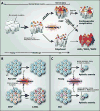Concise Review: Age-Related Clonal Hematopoiesis: Stem Cells Tempting the Devil
- PMID: 29883022
- PMCID: PMC6125185
- DOI: 10.1002/stem.2845
Concise Review: Age-Related Clonal Hematopoiesis: Stem Cells Tempting the Devil
Abstract
The recent characterization of clonal hematopoiesis in a large segment of the aging population has raised tremendous interest and concern alike. Mutations have been documented in genes associated with hematological cancers and in non-driver candidates. These mutations are present at low frequency in the majority of individuals after middle-age, and principally affect the epigenetic modifiers DNMT3A and TET2. In 10%-40% of cases, the clone will progress to meet the diagnostic criteria for Clonal Hematopoiesis of Indeterminate Potential, which is associated with an increased risk of hematological cancer and cardiovascular mortality. Blood cell parameters appear unmodified in these individuals, but a minority of them will develop a hematologic malignancy. At this time, the factors put forward as potentially influencing the risk of cancer development are clone size, specific gene, specific mutation, and the number of mutations. Specific stress on hematopoiesis also gives rise to clonal expansion. Genotoxic exposure (such as chemotherapy), or immune attack (as in aplastic anemia) selects/provides a fitness advantage to clones with a context-specific signature. Clonal hematopoiesis offers a new opportunity to understand the biology and adaptation mechanisms of aging hematopoiesis and provides insight into the mechanisms underlying malignant transformation. Furthermore, it might shed light on common denominators of age-associated medical conditions and help devise global strategies that will impact the prevention of hematologic cancers and promote healthy aging. Stem Cells 2018;36:1287-1294.
Keywords: Aging; Hematologic malignancies; Hematopoiesis; Stem cells.
© AlphaMed Press 2018.
Conflict of interest statement
RL declare employment/leadership relationship with Qiagen. All other authors declared no conflict of interest.
Figures

References
-
- Ogawa T, Kitagawa M, Hirokawa K. Age-related changes of human bone marrow: a histometric estimation of proliferative cells, apoptotic cells, T cells, B cells and macrophages. Mech Ageing Dev. 2000;117(1–3):57–68. - PubMed
-
- Linton PJ, Dorshkind K. Age-related changes in lymphocyte development and function. Nat Immunol. 2004;5(2):133–9. - PubMed
-
- Guralnik JM, et al. Prevalence of anemia in persons 65 years and older in the United States: evidence for a high rate of unexplained anemia. Blood. 2004;104(8):2263–8. - PubMed
Publication types
MeSH terms
Grants and funding
LinkOut - more resources
Full Text Sources
Other Literature Sources
Medical

